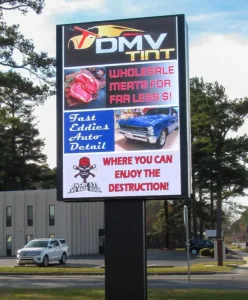Outdoor digital signage is growing at a rate of 10%+ a year as businesses, municipalities, and other organizations seek ways to increase visibility, capture the attention of passersby, and deliver timely and targeted messages that drive action.
As with their indoor counterparts, installing outdoor LED signs requires planning, coordination, and attention to detail to succeed. Here are a few things to keep in mind when specifying an outdoor digital sign:
Robust design
Outdoor signs have to be designed to accommodate a variety of manufacturing tolerances, environmental changes (sub-zero temperatures to above 100 F), wind stresses, etc. Under all of those conditions, the sign must not only function but also function well.
Manufacturing tolerances are especially important in outdoor digital signage. A single connection that is not perfect by the thickness of a few sheets of paper may not be a big issue by itself, but if this is multiplied by many connections (called a stack-up error), the chance of failure is great. To combat this, look for a manufacturer skilled at designing and assembling products to accommodate tolerances so installation is easier and signs are more reliable.
 Zoning and building codes
Zoning and building codes
Zoning codes have not kept pace with today’s LED sign technology in many areas. Some municipalities don’t differentiate between various electronic signs, so it may fall on the sign company to educate officials about the differences.
LED signs are technically advanced and designed to overcome concerns about light emission and distractions to people driving by, and with the right design, they can be no more distracting than static, backlit, or neon signs. A quality-designed LED sign can be programmed to be brighter when needed during the day and automatically dim at night.
Likewise, many building codes do not address the unique power-conserving benefits of LED signs. Unlike neon signs that require several thousand volts of power, LED signs use the same amount of power that can be found in a residential home and then reduce that power to the equivalent of three AA batteries connected in a series. LED signs operate on lower voltages because they are made with miniature LED diodes that are powered on or off to create an image. In other words, they are more similar to large TVs than to traditional bulb-based or neon electronic signs.
The structural requirements for LED signs are similar to other electronic signs. The biggest consideration is not weight but wind, which places significant forces on signs. Designing for wind load results in structures that can bear up to 10 times the weight of the sign. The sign itself must be extremely rigid and built to last over time. It’s important to be familiar with sign codes to ensure a correct installation.
 Installation planning
Installation planning
The installation of outdoor signage takes additional planning. Project managers are needed to coordinate the completion of the installation, working with all parties to bring the customer’s expectations into reality. Planning includes ensuring that permits are secured, the job site work is complete, and access roads are clear. Failing to consider the entire process could result in costly delays.
Once a site is chosen, the installation team must determine how to get the structure, sign, and electrical to that location. Consideration must be given to the layout of the job site for equipment, cranes, delivery trucks, an assembly area, and routing of electrical. In addition, thought must be given to how operators will communicate with the sign. Most LED signs are programmed over a cellular network to avoid having to install local hardline communication networks, so it’s important to ensure sufficient cellular coverage.
Finally, be patient and assemble a great team — including a display manufacturer that will be involved throughout the project, is experienced in supporting outdoor installations, and has a reputation for manufacturing reliable LED signs that work in all kinds of weather.


 Zoning and building codes
Zoning and building codes Installation planning
Installation planning


